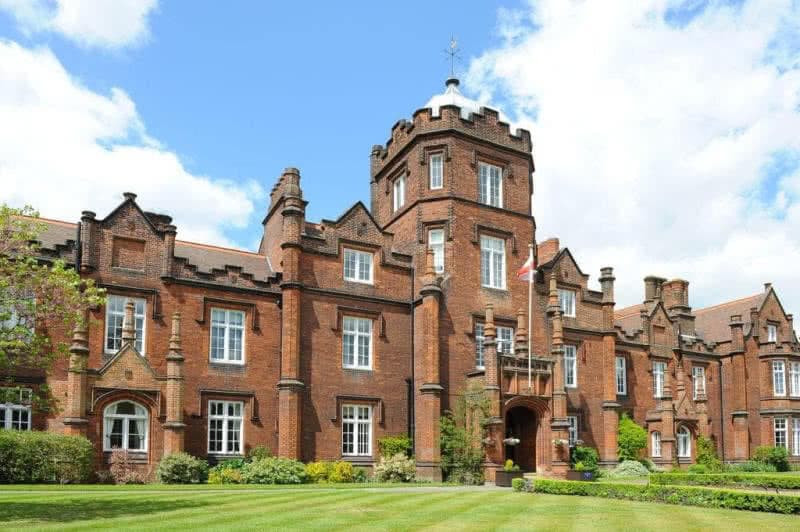The earliest record of Ipswich School is a bill, sadly unpaid, dating back to 1399. The school, which has Cardinal Thomas Wolsey as one of its former pupils, was established on several different sites throughout Ipswich until it moved to Henley Road.
Prince Albert laid the foundation stone for the Henley Road building in 1851. Acknowledging its Tudor past, the school has a tower, reminiscent of both the Dean’s Turret House of Cardinal College and Christchurch’s Tom Tower at Oxford, and a main entrance recalling Wolsey’s Gate – which can be found near Ipswich Waterfront.
Otherwise, the frontage is Elizabethan in nature, in keeping with Headmaster Rigaud’s keenness on Queen Elizabeth’s Letters Patent to the school of 1566, which re-established the school’s Royal Charter.
The new schoolroom ran well over budget, but took only a year to build and was occupied on 1 July 1852, by which time Headmaster Rigaud had already raised the funds for an adjacent chapel, later joined to the school. This can be seen to the right of the main entrance as you look at the school from Henley Road.
Also to the right of the main entrance, just before the chapel, is the Headmaster’s study, which houses the Old Town Library, a collection of books dating back to the 1400s. The school holds this collection on behalf of the town of Ipswich.
While the traditional method of teaching all classes in one room continued for several decades after the completion of the Henley Road schoolroom, with time, new classrooms were added and laboratories built.
These included an indoor swimming pool which was a rarity when it was constructed in 1884, and is still going strong today. The Duke of Edinburgh visited the school in 1956 to lay the foundation stone of the Great School, which is now used as a concert venue and for school performances, and again in 1973 to open the Leggett Technical Studies Centre which made the school one of the first in the country to have an engineering department.
The school library was designed by award winning architect Birkin Haward, and features stained glass windows by John Piper, which depict the four seasons. The main school building, chapel and library all have Grade II listed status.
Ipswich Preparatory School, founded in 1883, has had homes at both the north and south ends of the school. The Upper Prep now occupies a building on Ivry Street which recalls Ipswich’s maritime roots with its ship-like design, while the Lower Prep borders Anglesea Road. The Lodge Day Nursery, which caters for children from three months, was originally the Adjutant’s house from the former army barracks in Ipswich.
In 2019 Ipswich School purchased the Anglesea Heights site, adding to its portfolio of buildings in the area, and enabling expansion of boarding provision and the Prep School.
Distinguished pupils
Ipswich School can claim a number of distinguished former pupils: Thomas Wolsey, Cardinal, Archbishop of York and Lord Chancellor of England under Henry VIII, almost certainly attended the school. Eminent men of action include Thomas Howard, Duke of Norfolk, the English commander at the battle of Flodden, and Rear Admiral Sir Philip Broke. He captained HMS Shannon in a celebrated engagement with the USS Chesapeake. The novelist Henry Rider Haggard was a pupil here in the 1870s and distinguished artists such as Sir Edward Poynter, President of the Royal Academy, Charles Keene of Punch, and Edward Ardizzone attended the school. In the field of science, the pioneering neuro-physiologist and Nobel Prizewinner Sir Charles Sherrington is the most distinguished Old Ipswichian to date.
More recent Old Ipswichians include scientist, author and broadcaster Dr Adam Rutherford, and England and GB Hockey players Hannah Martin, Harry Martin, James Gall and George Pinner.
The Great War
Find out how we marked the hundredth anniversary of the armistice, which brought the Great War to an end and the role played by pupils of Ipswich School.
THE ONLY SCHOOL MENTIONED BY SHAKESPEARE
Among many interesting facts about Ipswich School is that it is the only school which is mentioned in any of Shakespeare’s works. The reference is in Henry VIII, Act iv, Sc. 2, in a reference to Cardinal Wolsey. Queen Catharine (Catharine of Aragon) is in her apartments at Kenilworth with her attendant, Griffith. They are speaking of Wolsey’s death and Katharine describes what she sees as the corruption of the man responsible for her divorce from the King. Griffith, however, speaks well of Wolsey and describes his commitment to education. The ‘twins of learning’ were the school in Ipswich, the Cardinal College of St. Mary, built by Wolsey to give his old school a grand home and its sister, Cardinal College, Oxford.
Click here for a link to our online Museum and Archives: http://www.ipswichschoolmuseumandarchives.co.uk/


